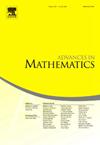Intersection probabilities for flats in hyperbolic space
IF 1.5
1区 数学
Q1 MATHEMATICS
引用次数: 0
Abstract
Consider the d-dimensional hyperbolic space of constant curvature and fix a point o playing the role of an origin. Let L be a uniform random q-dimensional totally geodesic submanifold (called q-flat) in passing through o and, independently of L, let E be a random -flat in which is uniformly distributed in the set of all -flats intersecting a hyperbolic ball of radius around o. We are interested in the distribution of the random γ-flat arising as the intersection of E with L. In contrast to the Euclidean case, the intersection can be empty with strictly positive probability. We determine this probability and the full distribution of . Thereby, we elucidate crucial differences to the Euclidean case. Moreover, we study the limiting behavior as and also . Thereby we obtain a phase transition with three different phases which we completely characterize, including a critical phase with distinctive behavior and a phase recovering the Euclidean results. In the background are methods from hyperbolic integral geometry.
双曲空间中平面的相交概率
考虑恒定曲率K<;0的d维双曲空间MKd,固定一个点0作为原点。让L是一个统一的随机q-dimensional全测地子流形(称为q-flat)在MKd通过o,独立于L,让E是一个随机的(d−q +γ)产品——MKd均匀分布在所有的集合(d−q +γ)公寓相交一个双曲球的半径标签;0啊。我们感兴趣的分布随机产生的γ产品——与L . E的交集与欧几里得情况下,十字路口E∩L可以用严格的积极的概率是空的。我们确定了这个概率和E∩L的完整分布。因此,我们阐明了与欧几里得情况的关键区别。此外,我们研究了d ^∞和K ^ 0时的极限行为。因此,我们得到了一个具有完全特征的三个不同相的相变,包括一个具有独特行为的临界相和一个恢复欧几里得结果的相。背景是来自双曲积分几何的方法。
本文章由计算机程序翻译,如有差异,请以英文原文为准。
求助全文
约1分钟内获得全文
求助全文
来源期刊

Advances in Mathematics
数学-数学
CiteScore
2.80
自引率
5.90%
发文量
497
审稿时长
7.5 months
期刊介绍:
Emphasizing contributions that represent significant advances in all areas of pure mathematics, Advances in Mathematics provides research mathematicians with an effective medium for communicating important recent developments in their areas of specialization to colleagues and to scientists in related disciplines.
 求助内容:
求助内容: 应助结果提醒方式:
应助结果提醒方式:


